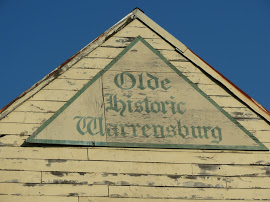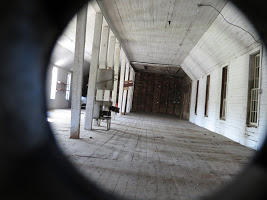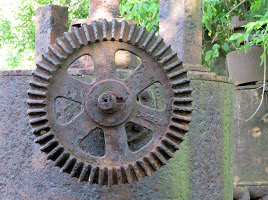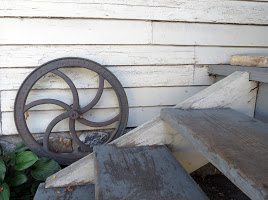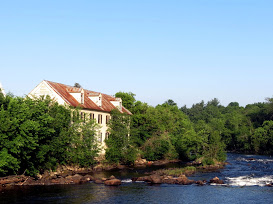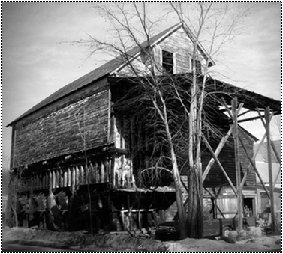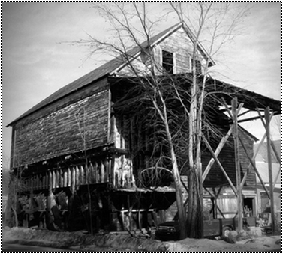 Coal pocket, c.2000, prior to August 2011 fire. (Photo Museum collection)
Coal pocket, c.2000, prior to August 2011 fire. (Photo Museum collection)
The district boundary is as follows: on the north side of the Schroon River the boundary. runs along the river at a distance of twenty-five feet from it. At the eastern end of the district this northern boundary widens to include a parcel of property owned by Niagara Mohawk (in 1974). It continues eastward to include three houses on Elm Street (no. 1, 2 and 4). Thence the boundary plunges southwards to cross the river on the east side of the Osborne Bridge, also east of numbers 44 River Street and number 4 Ridge btreet. It then turns westward to follow the D and H railroad right of way as
far as a point just south of number 70 River Street. From this point westward, the southern boundary is located two hundred feet south
of River Street and terminates just west of the Woolen Mill Bridge.
Thence it runs northward along the west side of the bridge to join
the point of origin on the north side of the river. Two new structures
housing. a lumber c0mpany (numbers• 104 and 106 River) are omitted from -
the district.
Coal Pocket – In 1921 A. C. Emerson Company constructed a modern coal elevator to store 1,000 tons of coal in eight separate "pockets." Coal delivered by the Delaware and Hudson Railroad was raised to the top of the three-storey building by an electric conveyor and transferred to a specific bin (or pocket) according to size. Coal was the preferred source of heating during the decades before World War II. Unused for decades, the building burned to the ground on August 22, 2011.
far as a point just south of number 70 River Street. From this point westward, the southern boundary is located two hundred feet south
of River Street and terminates just west of the Woolen Mill Bridge.
Thence it runs northward along the west side of the bridge to join
the point of origin on the north side of the river. Two new structures
housing. a lumber c0mpany (numbers• 104 and 106 River) are omitted from -
the district.
Coal Pocket – In 1921 A. C. Emerson Company constructed a modern coal elevator to store 1,000 tons of coal in eight separate "pockets." Coal delivered by the Delaware and Hudson Railroad was raised to the top of the three-storey building by an electric conveyor and transferred to a specific bin (or pocket) according to size. Coal was the preferred source of heating during the decades before World War II. Unused for decades, the building burned to the ground on August 22, 2011.
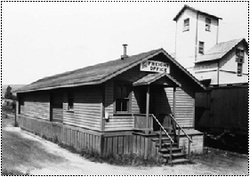 1929 Freight office (Jon Patton collection)
1929 Freight office (Jon Patton collection)
D & H Railroad Freight Office opened in Warrensburg on April 15, 1907. Stephen B.
Griffing, who had been at the station
in Thurman for the
previous 25 years, was placed in charge with George N. Lane as his assistant. The office consisted of an old passenger coach in back of the shirt factory, with two box cars for the freight house until 1929, when a typical freight office building was constructed at 1 Mill Avenue. George N. Lane became manager in 1908 and continued until 1940, when Albert C. Anderson assumed his duties. The office was closed in 1963.
 D. E. Pasco Hardware Store, River Street, now Curtis Lumber. (Museum photo)
D. E. Pasco Hardware Store, River Street, now Curtis Lumber. (Museum photo)
D. E. Pasco & Sons Hardware Store, grain storehouse and grist mill were previously owned by B.P. Burhans & Son. Thomas Smith of Horicon was the manager in 1882. In 1886 he moved to Warrensburgh and purchased the business from
Burhans, eventually turning it over
to his son Frank. Around 1927 Frank sold it to Delbert E. Pasco. Delbert died in 1948 and his
son Walter took over. Walter's son, Delbert H. Pasco, and nephew, Robert Pasco would eventually become owners. In 1967 the hardware store was sold to Curtis
Lumber. The grist mill was purchased by Nancy Fitler and turned into a restaurant by 1976. In 1980 the grain storehouse was sold to Bruce
Frulla, who built a large one-story
building and opened as War-rensburg Agway, selling hardware and
building supplies. In July 1986 the
property was sold to members of the Schiavi family who opened a furniture store,
"Designer Furniture: Strate from the Crate." Subsequently the newer building would become
a CWI workshop
and the older granery building was sold to Brad Jamison who operates a business under the name of
"The Birdhouse."
 Freight terminus in Warrensburg, at A. C. Emerson Company. Shirt factory building, now Lizzie Keays Restaurant, is at rear right. The photo predates the construction of the grain elevator and coal pocket. (Richards Library collection)
Freight terminus in Warrensburg, at A. C. Emerson Company. Shirt factory building, now Lizzie Keays Restaurant, is at rear right. The photo predates the construction of the grain elevator and coal pocket. (Richards Library collection)
Railway Express Agency - During World War I, the United States Railway Administration (USRA) took over the nation's railroads. Under the USRA, the four major express companies (Adams Express Company, Southern Express Company, American Express Company and Wells Fargo) and three minor ones were consolidated as American Railway Express, Inc. In March 1929, the assets and operations of American Railway Express Inc. were transferred to Railway Express Agency (REA). REA was owned by 86 railroads in proportion to the express traffic on their lines - no one railroad or group of railroads had control of the agency. Lester Love and his wife were agents in Warrensburg from 1909 until 1953. From 1927-30 the office was located in the Straight Block (Wills) before moving to the Love's home at 6 Mountain Ave. Lewis Crandall took over the service in 1954.
